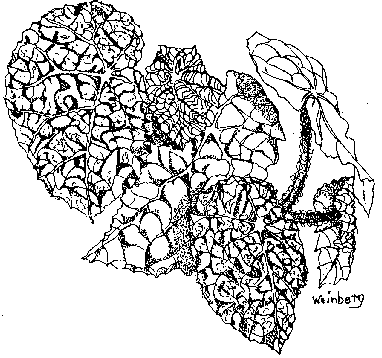B. gehrtii was discovered in Brazil, and described by Irmscher in 1959. It is in Section Pritzelia.
B. gehrtii is a rhizomatous begonia with distinctive foliage. Leaves are large, ovate, crispy, shiny, rugose, and medium green in color with sparse tan wool over the upper surface. The leaves have an elongated basal lobe which overlaps to form a small opening at the leaf base. Veins are pale green in color. The underside of the leaves are pale green with sparse tan wool on the veins. Petioles are cylindrical and tomentose. Flowers are white. Bloom occurs in winter.
B. gehrtii grows best with cool temperatures. It is best grown in the house or in a shady location within the greenhouse during the summer months, as leaf burn and wilt caused by breezes and overly warm temperatures will leave your plant with many damaged leaves in a very short time. I have been most successful at growing B. gehrtii in the basement during the summer, as this area is at least 10 degrees cooler than the rest of the house.
There are two plants that look very much like B. gehrtii: B. paulensis A. DC. and B. moysesii Brade. Both plants have the same leaf color and texture as B. gehrtii but there are distinct differences. B. paulensis‘ leaf is eltate, with a more rounded shape. B. moysesii has the elongated basal love of gehrtii, but their petioles differ: moysesii has a four-sided petiole and no hairs.
There is another likeness between B. gehrtii and B. paulensis. Both plants have leaves that will root as cuttings, but never form a plantlet from the leaf.
CULTURE
Light: Good light is essential, but do not place this begonia in the sun. In a greenhouse, give it a shady location. Under light garden conditions it can take a much brighter situation.
Temperature: Comfort range for B. gehrtii is 65-75 degrees F., but it takes temperatures in the lower 60’s very well.
Humidity: Ideal humidity is 50-60%
Water: Give water when the soil feels slightly dry to the touch. If allowed to dry beyond this point leaves will look pale and limp. Note: a good time to transplant B. gehrtii is when the soil is slightly dry, as leaves will be more flexible; gehrtii‘s leaves are normally quite crisp and tend to crack when handled.
Growing medium: Use a mix that will retain some moisture, but still have good drainage.


